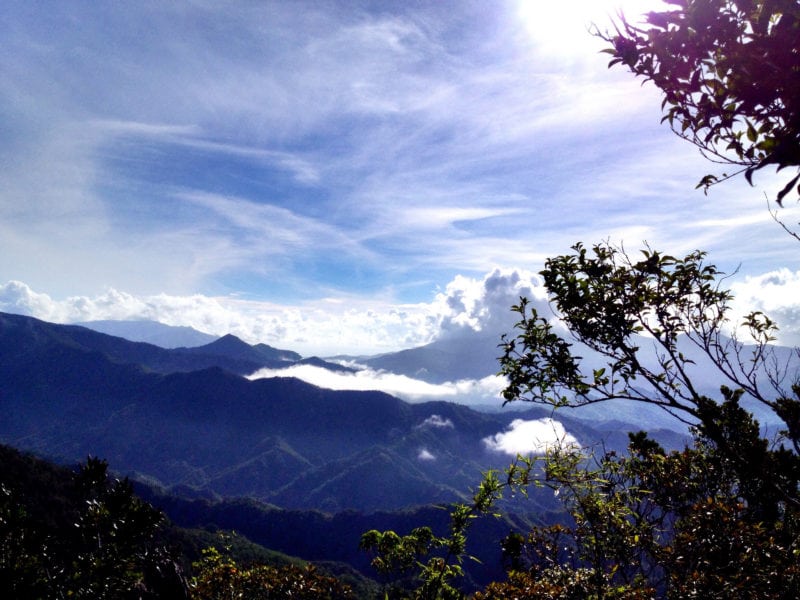Mt. Daraitan – This hike-worthy mountain is situated in the heart of Sierra Madre in Tanay, Rizal. Mt. Daraitan is very popular in the mountaineering community because aside from its magnificent view it also has a lot to offer including outdoor attraction such as a river, caves, limestone formations, and natural pools. Mt. Daraitan probably the longest and the hardest hike I’ve ever done by far. Nevertheless, it is also one of the best experience I had since I started mountaineering.
Major jumpoff: Brgy. Daraitan (village center), Tanay
Minor jumpoff: Sitio Cablao Brgy. Pagsangahan, General Nakar
LLA: 14°36′48.5′′N 121°26′19.5′′ E, 739 MASL (+600)
Days required / Hours to summit: 1 day / 2.5-4 hours
Specs: Minor climb, Difficulty 4/9, Trail class 1-3
Features: Tropical forest, limestone formations, river trek
– pinoymountaineer
Minor jumpoff: Sitio Cablao Brgy. Pagsangahan, General Nakar
LLA: 14°36′48.5′′N 121°26′19.5′′ E, 739 MASL (+600)
Days required / Hours to summit: 1 day / 2.5-4 hours
Specs: Minor climb, Difficulty 4/9, Trail class 1-3
Features: Tropical forest, limestone formations, river trek
– pinoymountaineer
THE CLIMB
Mt. Daraitan was surprisingly challenging. The trail is a really straightforward assault even from the first part up to the summit. I never thought that this mountain would be more challenging than I expected. It was insanely 80% assault trail and only 20% were flat. Some of our colleagues were only first-timer so they might be surprised by the trail. A soft muddy trail surrounded by an abundant variety of trees welcomed us upon arriving at the jumpoff.
Truth be told, Mt. Daraitan is not one of the toughest mountains to hike. If you’re looking for an adrenaline-pumping, extremely challenging hike, then this might not be for the adventurous type of people. It’s just a minor climb with a difficulty level of four out of nine and a trail class of one to three. And you’ll only spare three to four hours to reach the summit. Nonetheless, it’s still worth the trek, especially for all first-timers out there. You’ll surely enjoy it and have a memorable getaway.
The climb is straightforward 600-meter ascent that might feel steep for some, but there are a lot of holds available and the trail is certainly well-maintained. Most parts were already cemented and there are local guides who will ensure your safety along the way and at the same time act as photographers to capture your best moments in the mountain. Absolutely, your hiking experience will totally be one for the books!
Tips to remember

- To avoid a jam-packed trek, go to Mt. Daraitan during weekdays.
- Bring your own food and share it with your guide. Hydrate well and bring lots of water.
- Restrooms are charged from 5 PHP to 20 PHP. Pay 20 PHP when using a table in Tinipak River. Carry sufficient cash for these expenses.
- Pack extra clothes, especially when you’re planning to swim.
- Essentials: Carry a headlamp or flashlight, so you’re ready when darkness comes and carry your camera as well. Wear hiking shoes or sandals as much as possible. Keep and secure your valuables well.
- Listen to your guide always.
- Put sunblock as there is not enough shade in the area.
- Leave footprints only. Respect and protect the nature and throw your trash properly.
- Simply have fun!
Trekking the magnificent Mt. Daraitan
Everyone deserves to take a breather at times. It never hurts to unwind and get closer to nature when you’re feeling stressed or exhausted with life. Hiking Mt. Daraitan is a perfect way to de-stress and enjoy even for a short while. It’s also a great activity to bond with your loved ones and spend some quality time together. So, get the best travel deals at Shopback today for a more budget-friendly journey with your family or friends.
Are there any things you can add when climbing Mt. Daraitan? Share them below!


Comments
Post a Comment